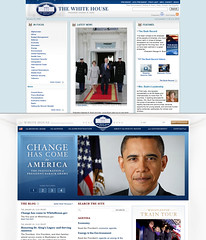One of the Obama campaign's promises was to increase transparency through technology, what policy wonks often call "new media". He seems to be fulfilling this promise through the newly redesigned www.whitehouse.gov, which takes on the look and feel of his campaign website and later change.gov. But these so-called improvements may not even be improving anything. As John Dickerson argued in a Slate article published shortly after the election in November, this newfound use of technology could simply be a new way of selling the administration's message. It's certainly been working on me: I check the blog on whitehouse.gov almost every day—it's been informative and useful in finding out just how the White House changes hands, how Washington evolves and inevitably stays the same as a new guy enters the Oval Office. The information also seems pretty objective, obviously supplemented with a few cross-references to the BBC, New York Times, The Economist, etc.
But does this really change anything? We've never seen a presidential campaign or administration use Internet technology to such a degree; access to the media has never been as integrated with the use of a computer as it is now. Had I been alive and politically conscious in 1960, I could have checked newspaper archives in microfilm and statistics in political almanacs in order to make sure that Kennedy and Nixon weren't twisting their facts. But it certainly wouldn't have been as easy as it is now. This, I think, and not the technology itself, is the key point. That the Obama administration actively encourages review of government policies using its website and that it freely releases Executive Orders and the like makes me confident that technology is not simply a campaign gimmick: it is a way to maintain the informed conversation between the government and the American people.





No comments:
Post a Comment